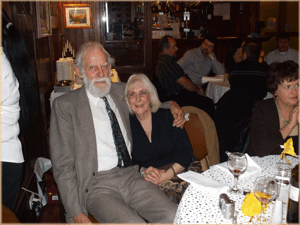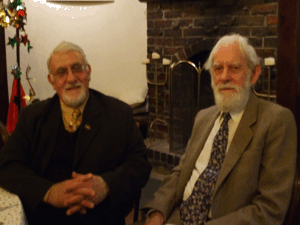|
|
 |
Astronomical Society |
|||||
|
Margaret and Frank, as many people did, became interested in astronomy in 1986 when Halley’s Comet revisited the earth. There is nothing like a major comet to kindle interest in what is out there! Frank bought a small telescope from Kmart and, with their then 16 year old son David, they travelled to the far north of South Australia in search of a dark sky. They became members of ASSA and Frank was soon engaged in building his own telescope. This involved grinding a mirror, which was accomplished by installing an empty 44 gallon drum in the back bedroom of their home, around which Frank walked, often with the family’s sulphur crested parrot, Solomon, on his shoulders as he used the piece of glass termed “the blank” to grind, with appropriately graded aluminium oxide, the actual glass that would form the mirror. The amount of concavity achieved after grinding was measured by means of projecting the image of the sun against the garage wall to establish the focal length suitable for the final telescope. Later the Ronchi test was used – a device that projected parallel lines on the glass, and which necessitated the person measuring the convexity lying on the floor in the hallway and peering at the glass over a distance confirmed the parabolic geometry. Then, when the correct concavity was achieved, the glass had to be silvered and mounted in a tube. The resulting 8 inch telescope worked magnificently, although when Jacky, Margaret and Frank’s teenage daughter, looked at Saturn she asked why the image was black and white and not quite like the photos of Saturn she had seen in books. “Aperture fever” affects most builders of telescopes, and Frank succumbed to this malady. He built a 12 inch telescope, which now resides at son David’s home. Later still Frank was infected by “Go To Mania” and purchased at vast expense a Meade computerised telescope which takes up a large amount of space in Margaret’s study where she does her writing. The Meade accompanies Margaret and Frank on many very enjoyable excursions with the Astronomical Society. The latest of these was to Mt Ive Station, in the Gawler Ranges. The ASSA members are a wonderful group. They have the stamina to spend their days four wheel driving over quite hair-raising terrain and their nights star-gazing. Most astronomers are interested in geology as well as in astronomy – the two interests go hand in hand. One of our most enthusiastic members is Professor Vic Gostin, who combines both disciplines in his teaching at the University of Adelaide. Other members include Bill Bradfield, who has discovered eighteen comets and who has an asteroid named after him.
An enjoyable tradition on the ASSA camps is the Sunset nibbles and drinks. A site where a spectacular sunset can be viewed is selected, nibbles and sherry is packed and the group enjoys this repast before returning in the dark to the campsite which is usually the shearers’ quarters of a sheep station. ASSA is a great social group apart from being a semi-professional astronomers’ club. Meetings are held at 8 pm on the first Wednesday night of the month in the Physics Department of the University of Adelaide when excellent speakers give lectures on diverse subjects. Past lectures have included “We Are not Alone: the Influence of the Cosmos on the Long History of Planet Earth” by Professor Ian Plimer and “The Void at the End of the Universe” by Professor Ray Norris. Visitors are welcome at the meetings. ASSA has an excellent website which can be reached at www.assa.org.au and publishes a monthly magazine called “The Bulletin”. A visit to the Observatory at Stockport is worthwhile as the Club is committed to educating the public about astronomy and members will happily show the general public around the skies. |
|||||||

